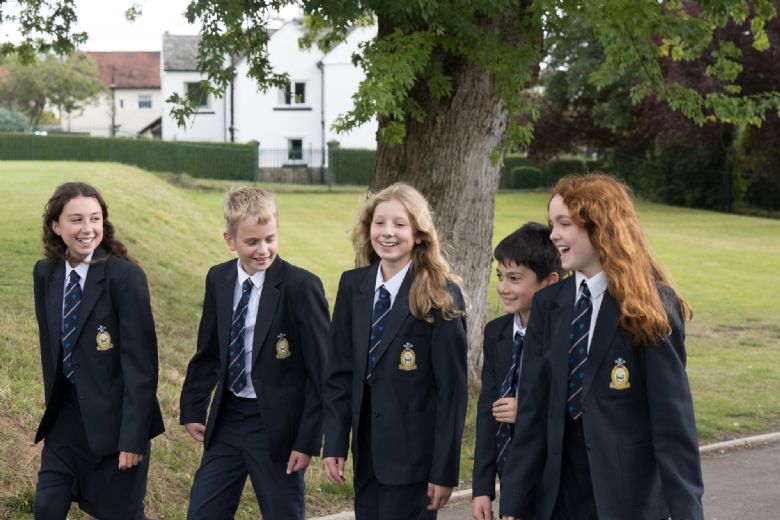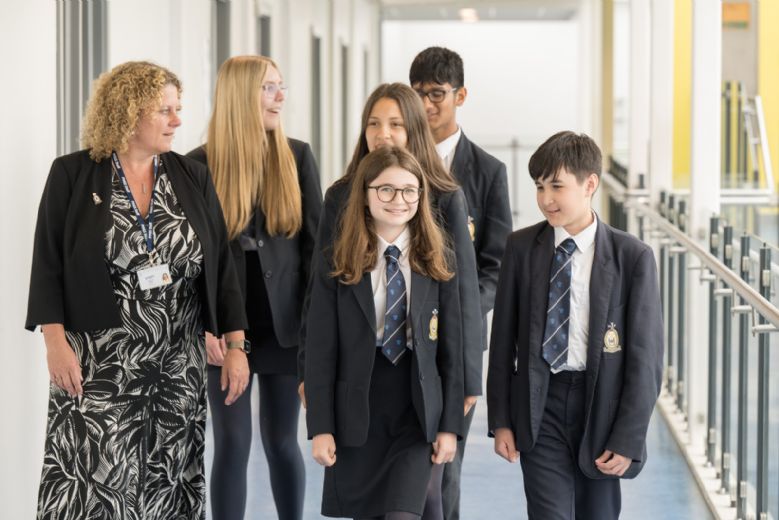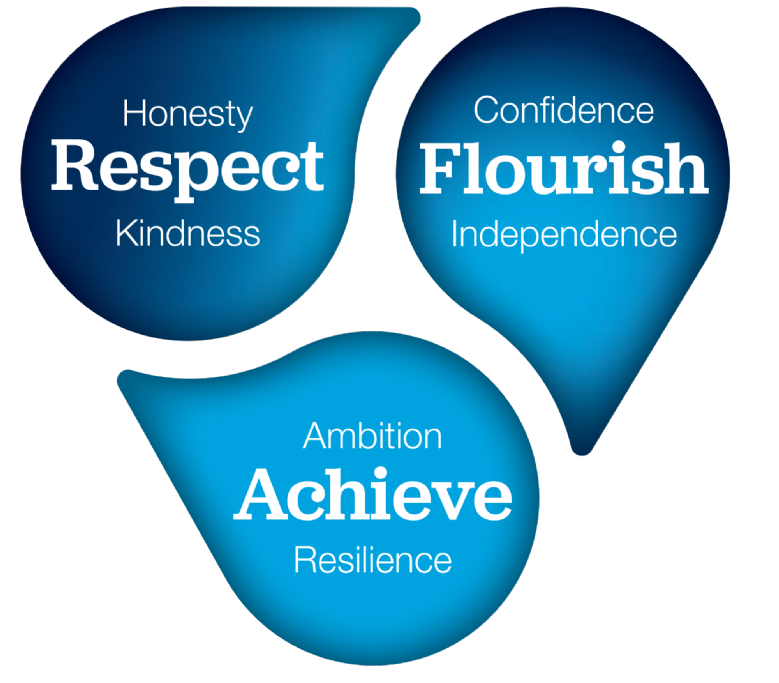A shared understanding of our Vision and Values
In September 2023 we launched our refreshed 'Vision and Values' statement and graphic. In this post, we consider why we need a shared understanding of what is important to us as a school. We also explain how we went about agreeing on just nine words to sum up all that we stand for.
It is commonplace in the corporate world for companies and products to look to sum up what they stand for – or what they are trying to achieve – in a memorable tagline or catchy slogan which rolls off the tongue. What do you think of (which may be partly dependent on your age!) when you see or hear phrases like “Because you’re worth it”, “Eat fresh”, “I’m lovin’ it” or “Just do it!”? Which car manufacturer comes to mind with “Vorsprung durch Technik”? Which bank promises to be “By your side”, and which breakfast cereal has been offering us “Snap! Crackle! Pop!” for almost a century?
What these companies are doing is trying to get us to remember them above their competitors, to establish a unique brand identity and to ensure that we think of them in a positive light. Admittedly, they may well also want to convey their mission, their purpose or their principles, but, ultimately, they want us to choose to give them our custom. That’s all part of good business and effective marketing, and a clever, memorable tagline is well worth the money spent developing it.
Of course, education is not about selling a product. Yes, all schools want to reflect a positive image and convey their distinctive features. You could say that, in this respect, it really isn’t that different to any other form of marketing, therefore – especially when it comes to recruiting potential students and members of staff.
However, I would argue that, in a school context, summing up what we stand for in a few words or phrases is much less about the message we are sending to the outside world, and much more about ensuring that everyone within the school knows what matters most and what we are wanting to achieve. That’s because, unlike buying some trainers or choosing a supermarket, education is not a ‘one-off transaction’ – or even a series of repeated transactions. It’s not a ‘moment in time’. Education is a process which takes place over many, many years, based on thousands of interactions every week with hundreds of different people within a particular ‘climate’. And every one of those interactions, each part of that climate contributes over time, with a sort of ‘drip feed’ effect, to helping our young people to learn, to develop and to grow.
 But why the need to sum this up in a ‘Vision and Values’ statement? In short, it’s about articulating with a shared language those things which we consider to be important, and sharing with everyone the part which they play in helping students to develop the positive characteristics which, we believe, will serve them well – for their own personal benefit, but equally for the ‘common good’ of the whole community – both during their time at Prince Henry’s and in their future role as adult citizens.
But why the need to sum this up in a ‘Vision and Values’ statement? In short, it’s about articulating with a shared language those things which we consider to be important, and sharing with everyone the part which they play in helping students to develop the positive characteristics which, we believe, will serve them well – for their own personal benefit, but equally for the ‘common good’ of the whole community – both during their time at Prince Henry’s and in their future role as adult citizens.
I have been at Prince Henry’s for well over 20 years, and if you had asked me up until last year what the school stood for, I think I – and most members of staff – would have listed similar things. A commitment to high achievement but, equally importantly, to being far more than ‘an exams factory’ churning out exam results year after year. A belief in enabling all students to thrive in the widest sense, based on positive relationships and rich opportunities outside the classroom – sports, performing arts, trips, visits.... High standards of behaviour so that all students can learn. A particular focus on equality and diversity and on a sense of responsibility as global citizens. Whether students would have listed the same things, I am less certain. I am also unsure whether, across this large organisation of 1,800+ students and staff, all of us would have named a common set of values which, as a school, we cherish above all else.
The appointment of a new headteacher served as the ideal opportunity for us to stop and ‘take stock’. We quickly agreed that, whilst we were proud of our positive school culture and what we would say makes the school special, we really did need to:
- ‘Step back’ and consider what we are really about as a school, what we want to achieve and what tangible ‘qualities’ we treasure most
- Consult widely to ensure that different perspectives be included
- Once agreed, develop a ‘punchier’, more memorable way of articulating our ‘Vision and Values’ so that it becomes part of a common language
- Finally, ensure that these then become a point of reference which inform our day-to-day life and work at school, and which we all aim to ‘live and breathe’
In this way, a year-long consultation and development process began. A key starting point for this were the results of the parent/carer survey (Easter 2022), in which 669 parents/carers shared their views. Although not focussed specifically on the school’s Vision and Values, this provided a number of common themes which informed the wider consultation.
Naturally, central to the consultation was the voice of our students. During the spring term we organised a series of separate ‘focus group’ discussions w ith student representatives from all seven year groups. Students were asked, in particular, to consider which positive characteristics they considered to be most important to enable them as individuals, but also wider society, to be both happy and successful – in the widest sense – both now and in the future.
ith student representatives from all seven year groups. Students were asked, in particular, to consider which positive characteristics they considered to be most important to enable them as individuals, but also wider society, to be both happy and successful – in the widest sense – both now and in the future.
In a similar way, staff teams were asked to consider what sort of culture we want for our school and what sort of people we want our students to be when they leave us. This built on the one-to-one introductory meetings which Sally Bishop, as new headteacher, held with each member of staff shortly after taking up post.
Perhaps not surprisingly, the consultation yielded a broad range of responses, including over 30 different words, like determination, curiosity, passion, open-mindedness, pride, adaptability, patience, tolerance, hard work, and aspiration. However, what was perhaps surprising was that, when ranked in terms of popularity, students and staff coincided exactly on their top six positive characteristics. (Or maybe it wasn’t that surprising after all, given what I have said above about us already having a distinctive school character - even though it may not have been articulated with shared language?)
Finally, as a Senior Leadership Team, we discussed the results of this extensive consultation and agreed on a simple Vision statement, setting out ‘the end goal’ – i.e. what it is we are working to achieve for our school:
“Prince Henry’s will become internationally recognised as an exceptional school with a culture of respect, where we can all flourish and achieve.”
This, in shorthand form, gives us our School Vision:
Respect – Flourish – Achieve.
Our vision is then underpinned by our six core School Values – the qualities or characteristics which we hold in highest esteem. With RESPECT comes honesty and kindness, whilst we all need to develop the confidence and independence to FLOURISH and the ambition and resilience to ACHIEVE.
Agreeing on the language that we use to articulate our Vision and Values is just part of what’s important, of course. What really matters is what everyone in our school community understands by these words – and what they actually do to embed them into the life and work of our school. I remember spending five years at my own school – a large comprehensive on the south coast, wearing my uniform with the school crest and motto of ‘Toujours prêt’ (French for ‘Always ready’) without ever stopping and asking myself what that actually meant. Ready for what? So what?
articulate our Vision and Values is just part of what’s important, of course. What really matters is what everyone in our school community understands by these words – and what they actually do to embed them into the life and work of our school. I remember spending five years at my own school – a large comprehensive on the south coast, wearing my uniform with the school crest and motto of ‘Toujours prêt’ (French for ‘Always ready’) without ever stopping and asking myself what that actually meant. Ready for what? So what?
Our job, then, is to make sure that Respect – Flourish – Achieve are never allowed to be just three words on a letterhead, but rather they frame everything we are about as a school. Equally, it is ensuring that we actively and systematically look for opportunities to teach, encourage and develop the traits of honesty, kindness, confidence, independence, ambition and resilience. Not just once, but every day - and in everything we do. Because education really isn’t like buying some trainers or choosing a supermarket.
